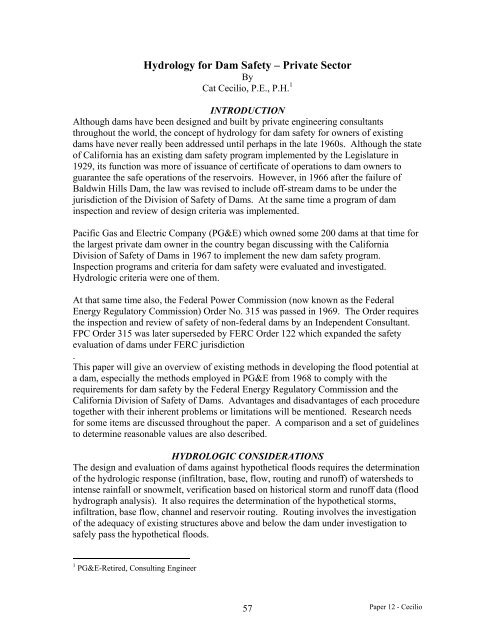Hydrologic Issues for Dams - Association of State Dam Safety Officials
Hydrologic Issues for Dams - Association of State Dam Safety Officials
Hydrologic Issues for Dams - Association of State Dam Safety Officials
Create successful ePaper yourself
Turn your PDF publications into a flip-book with our unique Google optimized e-Paper software.
Hydrology <strong>for</strong> <strong>Dam</strong> <strong>Safety</strong> – Private SectorByCat Cecilio, P.E., P.H. 1INTRODUCTIONAlthough dams have been designed and built by private engineering consultantsthroughout the world, the concept <strong>of</strong> hydrology <strong>for</strong> dam safety <strong>for</strong> owners <strong>of</strong> existingdams have never really been addressed until perhaps in the late 1960s. Although the state<strong>of</strong> Cali<strong>for</strong>nia has an existing dam safety program implemented by the Legislature in1929, its function was more <strong>of</strong> issuance <strong>of</strong> certificate <strong>of</strong> operations to dam owners toguarantee the safe operations <strong>of</strong> the reservoirs. However, in 1966 after the failure <strong>of</strong>Baldwin Hills <strong>Dam</strong>, the law was revised to include <strong>of</strong>f-stream dams to be under thejurisdiction <strong>of</strong> the Division <strong>of</strong> <strong>Safety</strong> <strong>of</strong> <strong><strong>Dam</strong>s</strong>. At the same time a program <strong>of</strong> daminspection and review <strong>of</strong> design criteria was implemented.Pacific Gas and Electric Company (PG&E) which owned some 200 dams at that time <strong>for</strong>the largest private dam owner in the country began discussing with the Cali<strong>for</strong>niaDivision <strong>of</strong> <strong>Safety</strong> <strong>of</strong> <strong><strong>Dam</strong>s</strong> in 1967 to implement the new dam safety program.Inspect ion programs and criteria <strong>for</strong> dam safety were evaluated and investigated.<strong>Hydrologic</strong> criteria were one <strong>of</strong> them.At tha t same time also, the Federal Power Commission (now known as the FederalEnergy Regulatory Commission) Order No. 315 was passed in 1969. The Order requiresthe inspection and review <strong>of</strong> safety <strong>of</strong> non-federal dams by an Independent Consultant.FPC Order 315 was later superseded by FERC Order 122 which expanded the safetyevaluation <strong>of</strong> dams under FERC jurisdiction.This paper will give an overview <strong>of</strong> existing methods in developing the flood potential ata dam, especially the methods employed in PG&E from 1968 to comply with therequirements <strong>for</strong> dam safety by the Federal Energy Regulatory Commission and theCali<strong>for</strong>nia Division <strong>of</strong> <strong>Safety</strong> <strong>of</strong> <strong><strong>Dam</strong>s</strong>. Advantages and disadvantages <strong>of</strong> each proceduretogether with their inherent problems or limitations will be mentioned. Research needs<strong>for</strong> some items are discussed throughout the paper. A comparison and a set <strong>of</strong> guidelinesto determine reasonable values are also described.HYDROLOGIC CONSIDERATIONSThe design and evaluation <strong>of</strong> dams against hypothetical floods requires the determination<strong>of</strong> the hydrologic response (infiltration, base, flow, routing and run<strong>of</strong>f) <strong>of</strong> watersheds tointense rainfall or snowmelt, verification based on historical storm and run<strong>of</strong>f data (floodhydrograph analysis). It also requires the determination <strong>of</strong> the hypothetical storms,infiltration, base flow, channel and reservoir routing. Routing involves the investigation<strong>of</strong> the adequacy <strong>of</strong> existing structures above and below the dam under investigation tosafely pass the hypothetical floods.1 PG&E-Retired, Consulting Engineer57Paper 12 - Cecilio

















